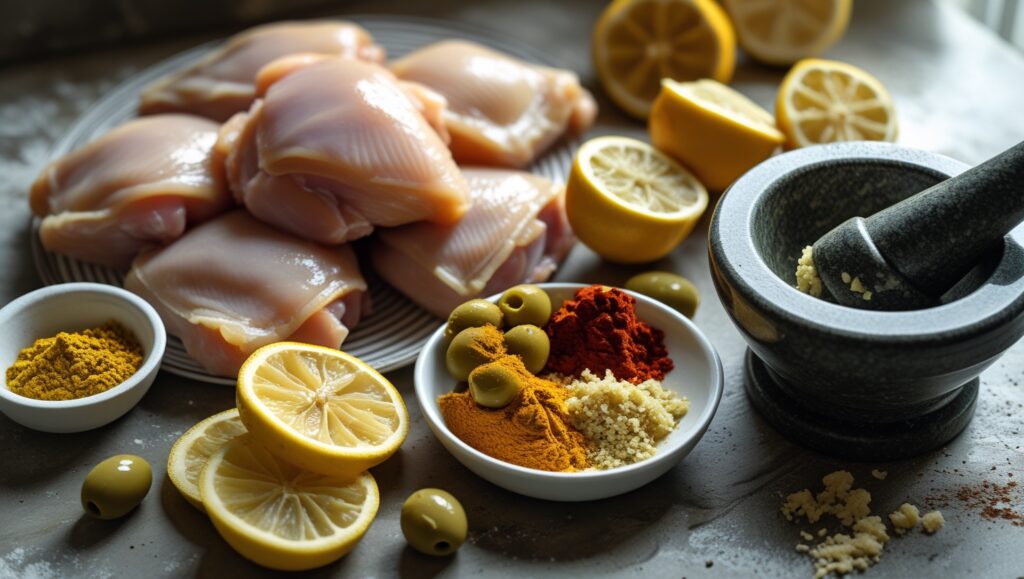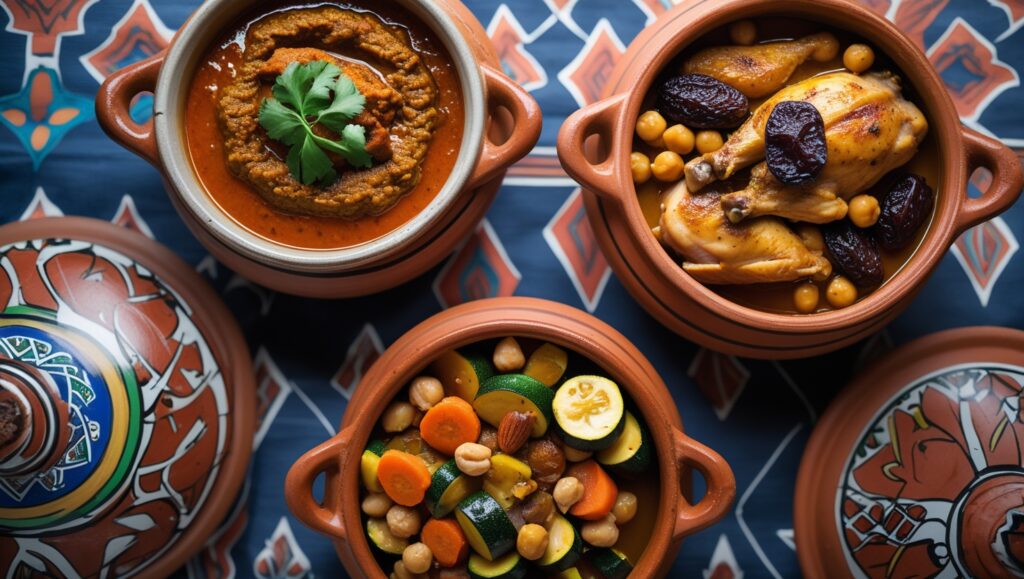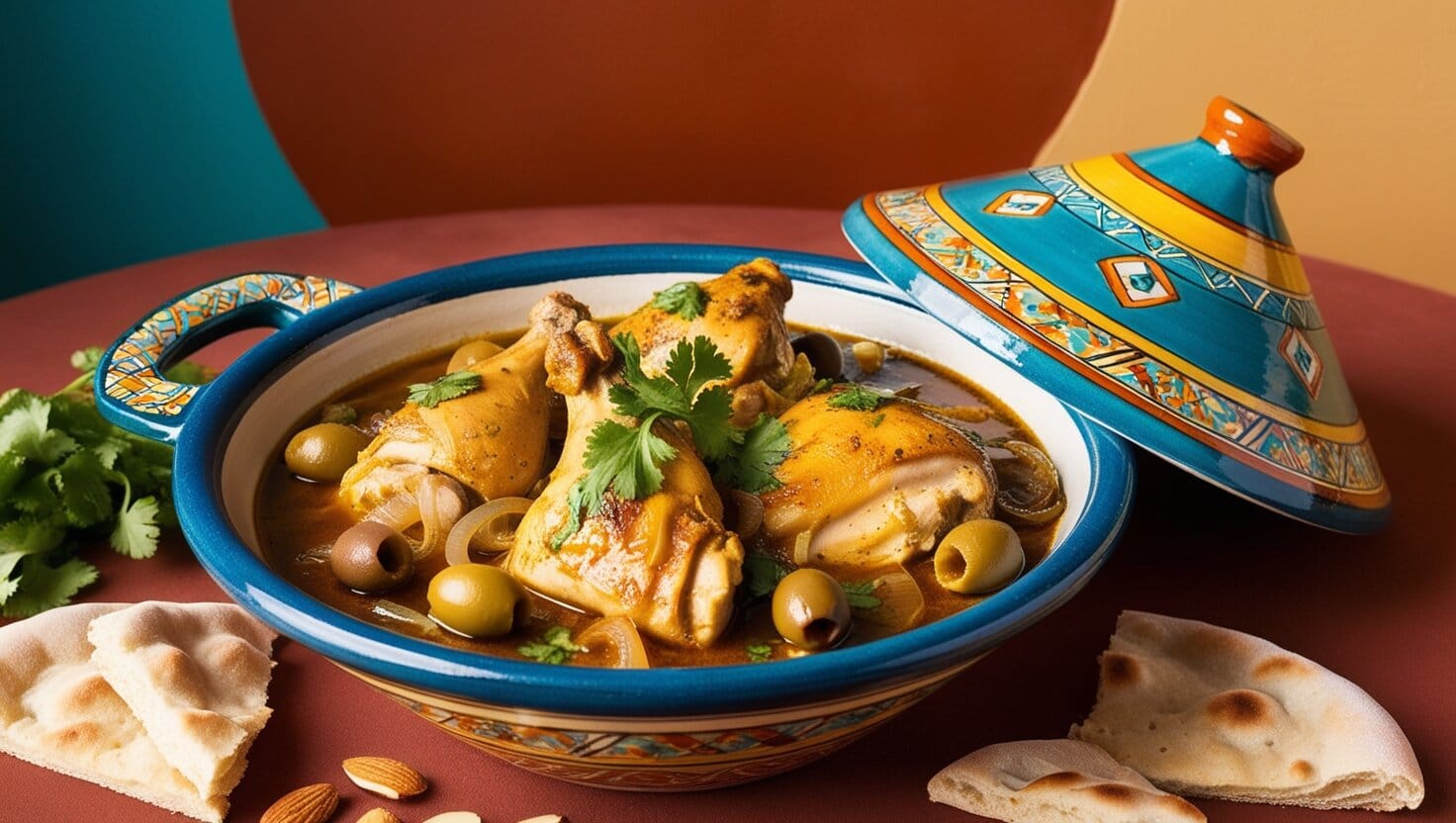Moroccan cuisine is a vibrant tapestry of flavors, and few dishes showcase this better than Moroccan Chicken Tagine. This slow-cooked, spice-infused dish is packed with rich aromas, tender meat, and a delicate balance of sweet and savory elements. Whether you’re a seasoned home cook or a beginner exploring global cuisines, learning how to make a proper Moroccan Chicken Tagine will take your culinary skills to the next level.
In this guide, we’ll cover everything you need to know—from its origins and essential ingredients to cooking techniques and serving suggestions. We’ll also explore various tagine variations, common mistakes to avoid, and answer frequently asked questions to ensure you master this Moroccan classic.
So, let’s dive in and uncover the secrets of Moroccan Chicken Tagine!
Introduction to Moroccan Chicken Tagine
What is Moroccan Chicken Tagine?
At its core, Moroccan Chicken Tagine is a slow-cooked stew featuring bone-in chicken, a medley of aromatic spices, preserved lemons, olives, and sometimes dried fruits like apricots or prunes. What makes it unique is the method of cooking—traditionally prepared in a tagine pot, a conical clay vessel that allows steam to circulate, locking in moisture and flavor. The result? A melt-in-your-mouth dish bursting with North African spices and rich umami depth.
Though often associated with Moroccan households, tagines aren’t just meals; they represent hospitality, tradition, and togetherness. Families gather around the pot, scooping up tender chicken and flavorful broth with freshly baked Moroccan bread or fluffy couscous.
The History and Cultural Significance of Tagine in Morocco
The word tagine refers both to the earthenware pot and the dish itself. Its origins trace back to the Berbers, the indigenous people of North Africa, who slow-cooked meats and vegetables over low heat to create nourishing meals in the harsh desert climate.
Over centuries, influences from Arab, Mediterranean, and Andalusian cuisines introduced new ingredients, such as saffron, cinnamon, and dried fruits, which are now signature elements of Moroccan tagines. Today, Moroccan Chicken Tagine is more than just a dish—it’s a symbol of Moroccan heritage, served at celebrations, family gatherings, and special occasions.
Now that we’ve explored the roots of this dish, let’s move on to the key ingredients that define an authentic Moroccan Chicken Tagine. Are you ready? Let’s get cooking!
Key Ingredients of Moroccan Chicken Tagine
A good Moroccan Chicken Tagine is only as delicious as the ingredients that go into it. The dish is built on a foundation of bold spices, tangy preserved lemons, briny olives, and succulent chicken, all slow-cooked to perfection. Let’s explore the must-have ingredients that bring this dish to life.
The Essential Spices: Cumin, Turmeric, Paprika, and More
Moroccan cuisine is famous for its warm, earthy, and aromatic spices, and chicken tagine is no exception. Here are the core spices that give the dish its distinctive taste:
- Cumin – Adds a nutty, slightly peppery depth.
- Turmeric – Brings a golden hue and mild bitterness.
- Paprika – Offers a smoky-sweet balance.
- Cinnamon – Introduces a subtle warmth.
- Ginger – Enhances the dish with a gentle heat.
- Saffron (optional but luxurious) – Provides a floral, honey-like aroma.
Preserved Lemons and Olives: The Signature Moroccan Flavors
One of the biggest flavor boosters in Moroccan Chicken Tagine is preserved lemons. These lemons, cured in salt and their own juices, add an intense citrusy tang that’s impossible to replicate with fresh lemons.
Another key ingredient? Olives. Whether you use green or black olives, they contribute a salty, briny bite that balances the dish’s richness.
Protein Choices: Chicken Thighs vs. Chicken Drumsticks
Traditionally, bone-in, skin-on chicken is preferred because it retains moisture during slow cooking. Chicken thighs and drumsticks work best, as they become fork-tender and absorb the flavors deeply. If you opt for boneless cuts, be mindful that they may cook faster and could dry out.
Using Dried Fruits Like Apricots and Prunes for Sweetness
Many versions of chicken tagine include dried fruits such as apricots, prunes, or raisins. These add a subtle sweetness that pairs beautifully with the savory and spiced components of the dish. If you love a more balanced contrast, consider adding a handful of almonds or toasted nuts for extra texture.
👉 For more inspiration, check out this authentic Moroccan Chicken Tagine recipe.
Traditional vs. Modern Cooking Methods
Cooking Moroccan Chicken Tagine is all about slow, gentle heat to allow the flavors to meld. While the traditional tagine pot is the gold standard, modern adaptations using Dutch ovens, slow cookers, and even Instant Pots make this dish accessible to everyone.
The Traditional Tagine Pot: Why It’s Special
A tagine pot is a clay or ceramic vessel with a cone-shaped lid that traps steam and recirculates moisture. This results in:
- Tender, juicy chicken
- Deep, concentrated flavors
- Minimal need for added liquid
Cooking in a traditional tagine requires low, slow heat to avoid cracking the pot. The key is to sauté aromatics first, then layer ingredients without stirring too much to preserve the texture.
Cooking Tagine in a Dutch Oven or Slow Cooker
Don’t have a tagine? No worries! A Dutch oven works just as well since it retains heat efficiently. To mimic a tagine’s effect, cover and cook over low heat for 1.5 to 2 hours.
For an even more hands-off approach, use a slow cooker:
- Sear the chicken first for extra depth.
- Cook on LOW for 6-8 hours or HIGH for 3-4 hours.
- Add olives and preserved lemons near the end to keep their flavors bright.
Can You Make Moroccan Chicken Tagine in an Instant Pot?
Absolutely! If you’re short on time, an Instant Pot can produce a flavorful tagine in under an hour. Use the sauté function for the spices and chicken, then pressure cook for about 20-25 minutes.
While this method speeds up cooking, the depth of flavor isn’t as pronounced as the traditional slow-cooked version. Still, it’s a fantastic way to enjoy Moroccan Chicken Tagine on a busy night.
Step-by-Step Moroccan Chicken Tagine Recipe

Now that we’ve covered the essential ingredients and cooking methods, it’s time to bring everything together with a foolproof Moroccan Chicken Tagine recipe. Follow these steps to create a dish bursting with traditional Moroccan flavors.
Preparing the Marinade: Spices, Garlic, and Olive Oil
For the most flavorful Moroccan Chicken Tagine, marinating the chicken is key. The longer the meat soaks in the aromatic spice blend, the deeper the flavor. Here’s how to do it:
- In a large bowl, mix:
- 2 tsp cumin
- 1 tsp turmeric
- 1 tsp paprika
- 1 tsp ground ginger
- ½ tsp cinnamon
- 2 tbsp olive oil
- 3 cloves garlic (minced)
- Juice of 1 lemon
- Salt and pepper to taste
- Coat the chicken well and let it marinate for at least 2 hours (overnight is best).
Sautéing the Aromatics: Onions, Garlic, and Ginger
- Heat 2 tbsp of olive oil in a tagine pot or Dutch oven over medium heat.
- Add 1 large onion (thinly sliced) and cook until soft and golden.
- Stir in 3 minced garlic cloves and 1 tbsp grated fresh ginger, cooking for another minute until fragrant.
Slow-Cooking the Chicken to Perfection
- Place the marinated chicken (skin-side down) into the pot. Sear for 3-4 minutes per side until lightly browned.
- Pour in 1 cup of chicken broth and a pinch of saffron (optional).
- Reduce heat to low, cover, and simmer for 45 minutes to 1 hour.
Adding the Final Touches: Olives, Lemons, and Herbs
- Slice 1 preserved lemon into quarters and stir it in along with ½ cup green olives.
- If using, add a handful of dried apricots or prunes for a sweet contrast.
- Cook for another 15 minutes, allowing the flavors to meld beautifully.
- Garnish with fresh cilantro and parsley before serving.
Best Side Dishes to Serve with Moroccan Chicken Tagine
A rich, fragrant dish like Moroccan Chicken Tagine deserves equally delicious side dishes. Here are the best accompaniments to complete your meal.
Couscous: The Perfect Companion
The most traditional pairing with chicken tagine is steamed couscous. This light, fluffy grain absorbs the flavorful sauce and balances the richness of the dish. To make it extra special, add:
- Toasted almonds or pine nuts for crunch
- Chopped dates or raisins for sweetness
- A drizzle of olive oil and fresh herbs for brightness
Moroccan Flatbread: A Staple Side Dish
If you prefer a heartier option, Moroccan khobz (flatbread) is the way to go. It’s perfect for scooping up the sauce and tender chicken pieces. Warm pita bread or naan also makes a great substitute.
Pairing Tagine with Traditional Moroccan Salads
A fresh, tangy salad balances the deep, spiced flavors of Moroccan Chicken Tagine. Try these authentic Moroccan side salads:
- Tomato and Cucumber Salad – Diced tomatoes, cucumbers, parsley, lemon juice, and olive oil.
- Zaalouk – A smoky eggplant and tomato salad.
- Carrot and Orange Salad – Sweet and citrusy with a hint of cinnamon.
For more Moroccan meal inspiration, check out this Moroccan Chicken Tagine recipe or explore other traditional Arabic dishes.
Variations of Moroccan Chicken Tagine

One of the best things about Moroccan Chicken Tagine is its versatility. Whether you love a spicy kick, a hint of sweetness, or a healthier twist, there’s a tagine variation for you. Here are some of the most popular ways to tweak this classic dish.
Spicy Harissa Chicken Tagine
If you love heat, harissa paste is the perfect addition to your Moroccan Chicken Tagine. Harissa is a North African chili paste made with roasted red peppers, garlic, cumin, and coriander. To create a spicy version, simply:
- Add 1-2 tablespoons of harissa to the marinade.
- Mix it into the broth for an extra fiery sauce.
- Garnish with fresh cilantro to balance the spice.
This version pairs beautifully with cooling yogurt sauce or cucumber salad to soothe the heat.
Sweet and Savory Chicken Tagine with Prunes
For a classic Moroccan contrast of sweet and savory, prunes or dried apricots are a must. This variation is often served at Moroccan celebrations due to its rich, festive flavors.
To make it:
- Add ½ cup of prunes or chopped apricots 30 minutes before the dish is done.
- Stir in 1 tbsp of honey for a caramelized depth.
- Sprinkle with toasted almonds or sesame seeds before serving.
The result? A luscious, aromatic dish that balances the warm spices with natural sweetness.
Vegetable-Loaded Chicken Tagine for a Healthier Option
Want a lighter, nutrient-packed version? Load your tagine with colorful vegetables! Some great additions include:
- Carrots and zucchini for texture
- Bell peppers for sweetness
- Chickpeas for extra protein
- Spinach or kale for a nutritious boost
This version is perfect for a well-rounded meal and pairs well with whole-grain couscous.
Tips and Tricks for the Perfect Moroccan Chicken Tagine
Mastering Moroccan Chicken Tagine takes practice, but these expert tips will help you achieve restaurant-quality results every time.
Common Mistakes to Avoid When Cooking Tagine
- Skipping the marinade – Let the spices infuse the chicken for at least 2 hours (overnight is best).
- Using too much liquid – A tagine pot traps steam, so you need less broth than usual. Adding too much will dilute the flavors.
- Cooking at high heat – Slow and low is the way to go! Too much heat can make the chicken tough.
- Stirring too often – Unlike stews, tagines should cook undisturbed to develop deep flavors.
How to Achieve the Perfect Balance of Flavors
The magic of Moroccan Chicken Tagine lies in the harmony of flavors. Here’s how to balance it perfectly:
- Spices: Adjust the mix to your taste. Add extra cumin for earthiness or cinnamon for warmth.
- Acidity: Preserved lemons and olives add a bright contrast—don’t skip them!
- Sweetness: If you use dried fruits, balance them with a little salt or lemon juice.
Storage and Reheating Tips for Leftovers
Tagine tastes even better the next day as the flavors deepen overnight. To store:
- Refrigerate: Keep leftovers in an airtight container for up to 3 days.
- Freeze: It freezes well for up to 3 months.
- Reheat: Gently warm on the stovetop over low heat to preserve texture.
With these tips, you’ll always have a flavorful and authentic Moroccan Chicken Tagine!
Frequently Asked Questions (FAQs)
When making Moroccan Chicken Tagine, you might have a few questions. Here are some common FAQs to help you perfect this dish.
What is the best chicken cut for Moroccan Chicken Tagine?
Bone-in, skin-on chicken thighs and drumsticks work best because they stay moist during slow cooking. Boneless chicken breasts can be used but may dry out unless cooked carefully.
Can I make Moroccan Chicken Tagine without a tagine pot?
Yes! While a traditional tagine pot gives the dish its authentic texture, a Dutch oven, slow cooker, or Instant Pot works just as well. A Dutch oven is the best substitute because it retains heat and moisture similarly.
How long should I marinate the chicken for the best flavor?
For the most flavorful Moroccan Chicken Tagine, marinate the chicken for at least 2 hours. If possible, let it sit overnight to absorb the spices fully.
What can I use instead of preserved lemons?
If you don’t have preserved lemons, try this quick alternative:
- Use fresh lemon zest and a teaspoon of salt.
- Let it sit for about 15 minutes to draw out the oils.
- Stir it into the dish when adding olives.
Though it won’t have the same deep, fermented tang, it will still add a bright, citrusy kick.
Conclusion and Final Thoughts
Making Moroccan Chicken Tagine at home is a rewarding experience that brings rich flavors, comforting warmth, and cultural tradition to your table. Whether you stick to the classic version or explore different variations, the key to a great tagine is patience, balance, and quality ingredients.
Why You Should Try Moroccan Chicken Tagine
This dish isn’t just about the flavors—it’s about tradition and togetherness. In Morocco, tagine is often enjoyed family-style, shared with loved ones over couscous or warm bread. Every bite tells a story of North African heritage, spice trade history, and culinary artistry.
Final Tips for the Best Moroccan Chicken Tagine
- Use fresh, high-quality spices for the most vibrant taste.
- Marinate the chicken overnight for deep, rich flavors.
- Cook low and slow—tagine is all about patience!
- Experiment with variations like spicy harissa or sweet prunes.
Whether you’re trying Moroccan cuisine for the first time or looking to refine your tagine skills, this dish is a must-try. Now, grab your spices, heat up your pot, and enjoy the magic of Moroccan Chicken Tagine!

